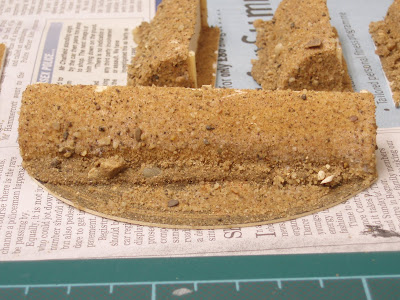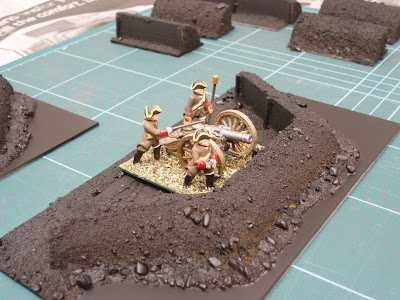Having been endlessly impressed by the terrain building I see elsewhere on the web (and also in the new series in "Battlegames"), when the time came to find some earthworks for the next AWI game, rather than go and buy them I decided to build my own...
In "Battlegames" the author recommends the use of flower arrangers foam (the material that flower arrangers poke the stems into), but as I'd already spotted something else that I thought would do the trick, I went with my first choice. Anyway without further ado - here's how mine came to see the light of day...
Materials:
 I'd been wandering round the local DIY superstore and I'd spotted some quarter round dowel (the stuff they use for beading, picture frames, etc.) in various sizes - I bought two lengths (they're about a metre long), one of about 20mm radius, and the other slightly smaller... I used the 20mm radius for this project as my figures are 25mm. Other materials used were some Starbucks wooden coffee stirrers (never let it be said that there isn't something you can use for wargaming in almost any environment!), standard wood glue, some plastic card, some matches, a scoop of gritty sand off the local beach, and some PVA.
I'd been wandering round the local DIY superstore and I'd spotted some quarter round dowel (the stuff they use for beading, picture frames, etc.) in various sizes - I bought two lengths (they're about a metre long), one of about 20mm radius, and the other slightly smaller... I used the 20mm radius for this project as my figures are 25mm. Other materials used were some Starbucks wooden coffee stirrers (never let it be said that there isn't something you can use for wargaming in almost any environment!), standard wood glue, some plastic card, some matches, a scoop of gritty sand off the local beach, and some PVA.
I started by cutting some of the dowel with an angled edge to make the redoubts - dowel is tough stuff, I used an electric saw, but if I was to do this again then the flower arrangers foam would be the better choice...
In order to get the traditional shape the angle of the cut needs to be greater than 45'(otherwise you end up with a right angle on each corner!); being an artist rather than a scientist (who would have sensibly made a template) I did mine by eye as I wanted something that looked like it had been built in a reasonable hurry...
The bases for my figures are 5cm square, so I made sure that the front of the redoubt was slightly bigger than this, the sides were about 3 - 4cm's. I also cut off a number of straights of 10cm or 5cm's to use as trench sections.
Once they were cut, I put a good gloop of wood glue on the bottom and stuck them down to some plastic car bases that I'd previously cut. When doing this, press the dowel down so that the back edge of the dowel goes down first, pushing excess glue towards the outer face of the trench. For the redoubt you can also put a good loop on the join between the front and sides. Don't worry about drips you're aiming to have a nice overflow on the front edge of the trench/redoubt.... while it's still wet, sprinkle the gritty/sand mix all over them. You can see what I mean here - notice how the sand "gathers" on the glue at the bottom of the trench face...

 Put them to one side to dry....
Put them to one side to dry....
Once they were dry, I then cut the stirrers to make planks for the base of the redoubts, I also cut match lengths to act as reinforcements for the uprights.
For the stirrers/planks I again used plenty of glue, and sprinkled more sand. Once I'd finished I put them aside again to dry - they were looking like this at this stage:

 Once they were fully dry, I then gave them a thinner coat of PVA glue on what would be the outer face of the trench, and the ends, and dipped them into the sand again - looking for texture now:
Once they were fully dry, I then gave them a thinner coat of PVA glue on what would be the outer face of the trench, and the ends, and dipped them into the sand again - looking for texture now:

 Once they'd had time to dry I gave them a light brush to get rid of the looser sand before I then gave them a really good coat of black primer as preparation for painting. This is them:
Once they'd had time to dry I gave them a light brush to get rid of the looser sand before I then gave them a really good coat of black primer as preparation for painting. This is them:
 ...and this is them with some figures for scale....
...and this is them with some figures for scale....

 ...next step will be the painting - I'll post separately on that.
...next step will be the painting - I'll post separately on that.
In "Battlegames" the author recommends the use of flower arrangers foam (the material that flower arrangers poke the stems into), but as I'd already spotted something else that I thought would do the trick, I went with my first choice. Anyway without further ado - here's how mine came to see the light of day...
Materials:
 I'd been wandering round the local DIY superstore and I'd spotted some quarter round dowel (the stuff they use for beading, picture frames, etc.) in various sizes - I bought two lengths (they're about a metre long), one of about 20mm radius, and the other slightly smaller... I used the 20mm radius for this project as my figures are 25mm. Other materials used were some Starbucks wooden coffee stirrers (never let it be said that there isn't something you can use for wargaming in almost any environment!), standard wood glue, some plastic card, some matches, a scoop of gritty sand off the local beach, and some PVA.
I'd been wandering round the local DIY superstore and I'd spotted some quarter round dowel (the stuff they use for beading, picture frames, etc.) in various sizes - I bought two lengths (they're about a metre long), one of about 20mm radius, and the other slightly smaller... I used the 20mm radius for this project as my figures are 25mm. Other materials used were some Starbucks wooden coffee stirrers (never let it be said that there isn't something you can use for wargaming in almost any environment!), standard wood glue, some plastic card, some matches, a scoop of gritty sand off the local beach, and some PVA.I started by cutting some of the dowel with an angled edge to make the redoubts - dowel is tough stuff, I used an electric saw, but if I was to do this again then the flower arrangers foam would be the better choice...
In order to get the traditional shape the angle of the cut needs to be greater than 45'(otherwise you end up with a right angle on each corner!); being an artist rather than a scientist (who would have sensibly made a template) I did mine by eye as I wanted something that looked like it had been built in a reasonable hurry...
The bases for my figures are 5cm square, so I made sure that the front of the redoubt was slightly bigger than this, the sides were about 3 - 4cm's. I also cut off a number of straights of 10cm or 5cm's to use as trench sections.
Once they were cut, I put a good gloop of wood glue on the bottom and stuck them down to some plastic car bases that I'd previously cut. When doing this, press the dowel down so that the back edge of the dowel goes down first, pushing excess glue towards the outer face of the trench. For the redoubt you can also put a good loop on the join between the front and sides. Don't worry about drips you're aiming to have a nice overflow on the front edge of the trench/redoubt.... while it's still wet, sprinkle the gritty/sand mix all over them. You can see what I mean here - notice how the sand "gathers" on the glue at the bottom of the trench face...

 Put them to one side to dry....
Put them to one side to dry....Once they were dry, I then cut the stirrers to make planks for the base of the redoubts, I also cut match lengths to act as reinforcements for the uprights.
For the stirrers/planks I again used plenty of glue, and sprinkled more sand. Once I'd finished I put them aside again to dry - they were looking like this at this stage:

 Once they were fully dry, I then gave them a thinner coat of PVA glue on what would be the outer face of the trench, and the ends, and dipped them into the sand again - looking for texture now:
Once they were fully dry, I then gave them a thinner coat of PVA glue on what would be the outer face of the trench, and the ends, and dipped them into the sand again - looking for texture now:
 Once they'd had time to dry I gave them a light brush to get rid of the looser sand before I then gave them a really good coat of black primer as preparation for painting. This is them:
Once they'd had time to dry I gave them a light brush to get rid of the looser sand before I then gave them a really good coat of black primer as preparation for painting. This is them: ...and this is them with some figures for scale....
...and this is them with some figures for scale....
 ...next step will be the painting - I'll post separately on that.
...next step will be the painting - I'll post separately on that.
Very nice... I will need to remember to look for those quarter-round dowels at the hardware store this weekend.
ReplyDeleteGreg
Very ingenious!... I made the mine from expanded polystyrene and plaster of Paris but your solution is more sturdy!
ReplyDeleteI agree. Not only do they look good, the tutorial is well presented. Thanks.
ReplyDelete-- Jeff
Great stuff - I am a fan of DIY terrain and I am always after new ideas. I look forward to the painted versions.
ReplyDeleteHi Steve,
ReplyDeleteThe neatest thing about using quarter round for fieldworks (Besides really looking the part!) is that they are (Pardon the pun) dirt cheap. A budding Vauban can have enough to cover the entire table for sieges and/or defensive battlelines, and still have enough left over in the ol' warchest to purchase those all important troops! Excellent pictures of the construction process too. They would make any Engineer tear up with pride 'cause he dug 'em, and make any infantryman weep 'cause he'd been ordered to take 'em!
excellent stuff Steve. Nice work and good presentation.
ReplyDeleteExcellent execution, I used to have a whole pile of brown painted quarter round dowel that I used for entrenchments. Quite a few years ago I rplaced them with some resin bits from Marbeth design. These were originally just straight sections, but I cut them down to match my figure frontages and added/modified section to provide ends and artillery emplacements.
ReplyDeleteI'll try and post some pictures on my blog.
Will
Thanks guys...
ReplyDeleteMartin - love the quote - might have to make that the title for the upcoming game! :o)
Will - please do - looks like Marbeth were bought out - the new owners are the Baggage Train(https://sslrelay.com/www.the-baggagetrain.co.uk/sess/utn;jsessionid=1548c7a9437e4e7/shopdata/index.shopscript) but they don't seem to have much in the way of trenches etc.